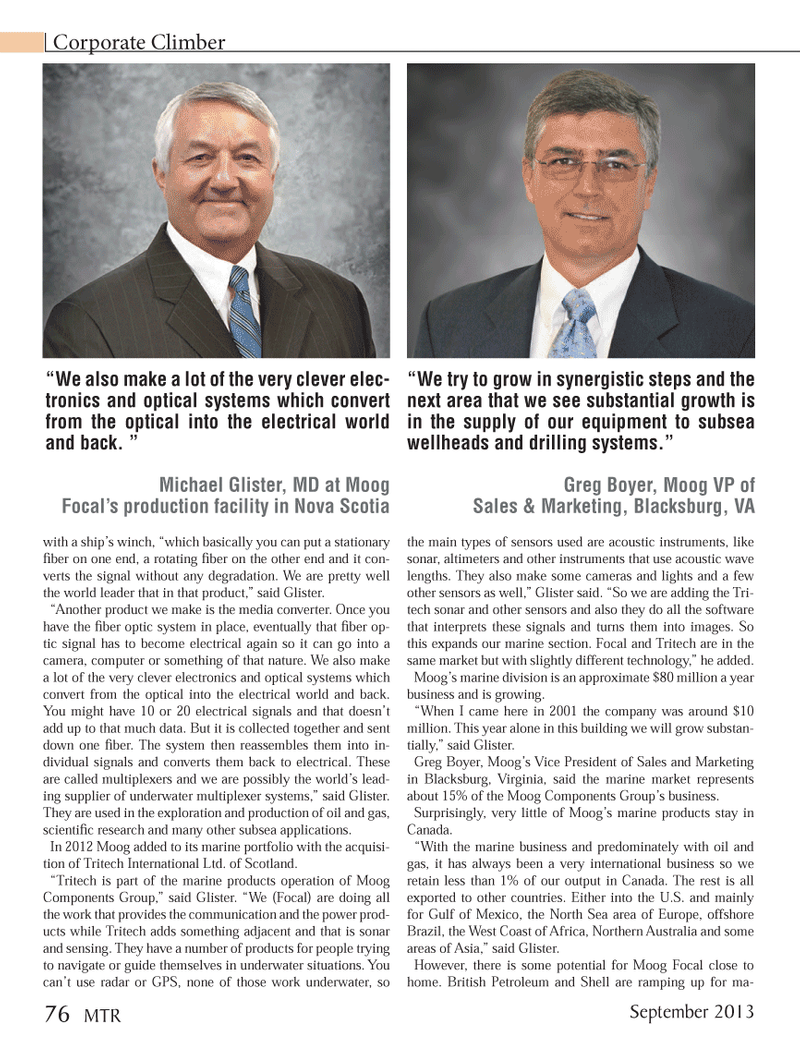
Page 76: of Marine Technology Magazine (September 2013)
Ocean Observation: Gliders, Buoys & Sub-Surface monitoring Networks
Read this page in Pdf, Flash or Html5 edition of September 2013 Marine Technology Magazine
with a ship?s winch, ?which basically you can put a stationary ber on one end, a rotating ber on the other end and it con- verts the signal without any degradation. We are pretty well the world leader that in that product,? said Glister. ?Another product we make is the media converter. Once you have the ber optic system in place, eventually that ber op- tic signal has to become electrical again so it can go into a camera, computer or something of that nature. We also make a lot of the very clever electronics and optical systems which convert from the optical into the electrical world and back. You might have 10 or 20 electrical signals and that doesn?t add up to that much data. But it is collected together and sent down one ber. The system then reassembles them into in- dividual signals and converts them back to electrical. These are called multiplexers and we are possibly the world?s lead- ing supplier of underwater multiplexer systems,? said Glister. They are used in the exploration and production of oil and gas, scienti c research and many other subsea applications. In 2012 Moog added to its marine portfolio with the acquisi-tion of Tritech International Ltd. of Scotland. ?Tritech is part of the marine products operation of Moog Components Group,? said Glister. ?We (Focal) are doing all the work that provides the communication and the power prod- ucts while Tritech adds something adjacent and that is sonar and sensing. They have a number of products for people trying to navigate or guide themselves in underwater situations. You can?t use radar or GPS, none of those work underwater, so the main types of sensors used are acoustic instruments, like sonar, altimeters and other instruments that use acoustic wave lengths. They also make some cameras and lights and a few other sensors as well,? Glister said. ?So we are adding the Tri- tech sonar and other sensors and also they do all the software that interprets these signals and turns them into images. So this expands our marine section. Focal and Tritech are in the same market but with slightly different technology,? he added. Moog?s marine division is an approximate $80 million a year business and is growing. ?When I came here in 2001 the company was around $10 million. This year alone in this building we will grow substan- tially,? said Glister. Greg Boyer, Moog?s Vice President of Sales and Marketing in Blacksburg, Virginia, said the marine market represents about 15% of the Moog Components Group?s business. Surprisingly, very little of Moog?s marine products stay in Canada.?With the marine business and predominately with oil and gas, it has always been a very international business so we retain less than 1% of our output in Canada. The rest is all exported to other countries. Either into the U.S. and mainly for Gulf of Mexico, the North Sea area of Europe, offshore Brazil, the West Coast of Africa, Northern Australia and some areas of Asia,? said Glister. However, there is some potential for Moog Focal close to home. British Petroleum and Shell are ramping up for ma-?We also make a lot of the very clever elec- tronics and optical systems which convert from the optical into the electrical world and back. ?Michael Glister, MD at Moog Focal?s production facility in Nova Scotia?We try to grow in synergistic steps and the next area that we see substantial growth is in the supply of our equipment to subsea wellheads and drilling systems.? Greg Boyer, Moog VP of Sales & Marketing, Blacksburg, VA Corporate Climber September 201376 MTRMTR #7 (66-81).indd 76MTR #7 (66-81).indd 768/23/2013 9:13:34 AM8/23/2013 9:13:34 AM

 75
75

 77
77
